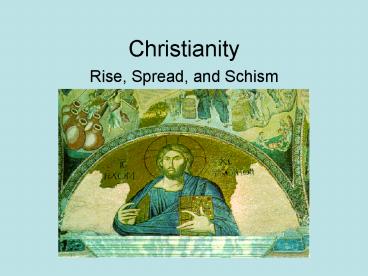Christianity PowerPoint PPT Presentation
1 / 17
Title: Christianity
1
Christianity
- Rise, Spread, and Schism
2
Roman Religious World
- By the imperial period, Rome had conquered many
peoples. - Very tolerant of other religions so long as they
did not disturb public order or undermine Roman
authority. - New emphasis on spirituality imported from the
Hellenistic world, particularly Persia.
3
Fresco from Pompeii, 1st century B.C.E.,
depicting a womans initiation into a mystery
religion.
Why do you think some cults and spiritual
communities were deemed mystery religions by
Romans and later historians?
4
Jewish Origins of Christianity
- Old Israel becomes Roman province of Judea in 63
B.C.E. Allowed to practice monotheistic worship
of Yahweh. - Judaism divided into sects
- Pharisees priests and rulers, wanted
independence from Rome (non-violent). - Sadducees priests, wanted to cooperate with
Rome. - Essenes mystery religion Dead Sea Scrolls.
- Zealots radical sect, supported violent
rebellion against Romans led revolt in 66 C.E. - All sects awaited the coming of a Messiah
(???????? anointed one) to reestablish Kingdom
of God.
5
The Messiah (?)
- To many, Jesus of Nazareth (6 B.C.E.-29 C.E.) was
that Messiah (to many more at the time he was
not). - Teachings expressed love and obedience to God.
- Sermon on the Mount.
- Crucified by Romans in 29 C.E. followers
reported his resurrection.
6
Crucifixion of Spartacus and other
slave rebels (71 B.C.E.)
Crucifixion of Jesus (29 C.E.)
7
Spread of Christianity
- Followers of Jesus proclaimed him the Christ
(???st?? anointed one) and their sect
Christianity. - Original Christians were primarily Jewish later
Gentiles too. - Teachings of Christianity attracted members of
certain social groups, particularly the poor and
marginalized. - Persecuted sect within Judaism.
8
Map of Judea around the time of Christ.
9
Paul of Tarsus
- Paul of Tarsus (3-67 C.E.) responsible for spread
of Christianity across Mediterranean. - Pharisaical Jew, Roman citizen.
- Established Christian churches in major Greek-
and Latin-speaking cities. - Epistles to churches.
10
(No Transcript)
11
Defining Christianity
- Paul was influential in defining key tenets of
Christianity and Christs teachings. - Resurrection of the dead and judgment.
- Parousia (parousiða appearance) imminent
Second Coming of Christ. - Incorporation of Gentiles.
- Creation of a patriarchy within the church.
- Definitions of moral (Christian) behavior.
12
Persecution by the State
- Criticism and persecution of Christians shifts
from Judaism to the Roman state. - Christians targeted for clannishness and refusal
to participate in state religion. - Nero (37-68 C.E.), first emperor to arrest, try,
and execute Christians. - Fire in Rome (July 64 C.E.) blamed on Christians.
- Regularly persecuted until 4th century.
13
Constantine the Great
- First Christian Roman emperor, Constantine
(272-337). - Converted in 312
- Founded city of Byzantium as a New Rome of the
East. - Edict of Milan (313)
- Council of Nicaea (325)
14
Edicts and Councils
- Edict of Milan (313)
- Declared Roman Empire would be neutral
regarding religious worship. - Return confiscated property
- Leads to Christianity becoming state religion of
Roman Empire - Council of Nicaea (325)
- Nature of Jesus (Trinitarianism v. Arianism)
- Date of Easter
- Heretics and lapsed Christians
- Nicene Creed
15
Mosaic from the Hagia Sophia at Constantinople
(Istanbul). Justinian I offers the church while
Constantine I offers the city to the Virgin Mary
and Christ.
16
East-West Schism
- Between 325 and 1045, Christianity slowly divided
between East and West. - Roman Empire already divided that way.
- Western church headed by a pope in Rome.
- Eastern church headed by a patriarch in
Byzantium/Constantinople. - Pope Leo IX and Patriarch Michael I excommunicate
each other in 1045. - Reasons for division
- Papal authority (Caesaropapism)
- Liturgical practices
- Iconoclasm
17
Russian Orthodox
Armenian Apostolic
Greek Orthodox
Roman Catholic
Syrian Orthodox
Copts
Ethiopian Orthodox

